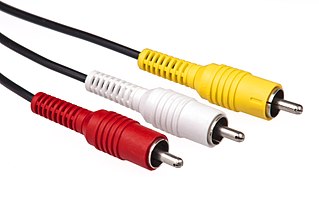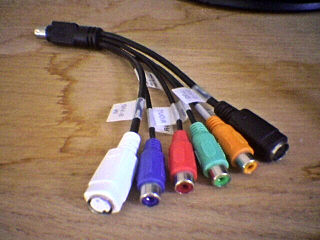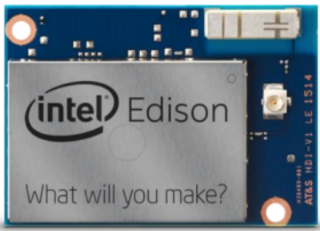
A sound card is an internal expansion card that provides input and output of audio signals to and from a computer under the control of computer programs. The term sound card is also applied to external audio interfaces used for professional audio applications.

An RF modulator is an electronic device used to convert signals from devices such as media players, VCRs and game consoles to a format that can be handled by a device designed to receive a modulated RF input, such as a radio or television receiver. Its input is a baseband signal, which is used to modulate a radio frequency source.

SCART is a French-originated standard and associated 21-pin connector for connecting audio-visual (AV) equipment. The name SCART comes from Syndicat des Constructeurs d'Appareils Radiorécepteurs et Téléviseurs, "Radio and Television Receiver Manufacturers' Association", the French organisation that created the connector in the mid-1970s. The related European standard EN 50049 was refined and published in 1978 by CENELEC, calling it péritelevision, but it is commonly called by the abbreviation péritel in French.

Composite video is an baseband analog video format that typically carries a 405, 525 or 625 line interlaced black and white or color signal, on a single channel, unlike the higher-quality S-Video and the even higher-quality YPbPr.

The RCA connector is a type of electrical connector commonly used to carry audio and video signals. The name RCA derives from the company Radio Corporation of America, which introduced the design in the 1930s. The connector’s male plug and female jack are called RCA plug and RCA jack.

S-Video is an analog video signal format that carries standard-definition video, typically at 525 lines or 625 lines. It encodes video luma and chrominance on two separate channels, achieving higher image quality than composite video which encodes all video information on one channel. It also eliminates several types of visual defects such as dot crawl which commonly occur with composite video. Although it is improved over composite video, S-Video has lower color resolution than component video, which is encoded over three channels.
GeoPort is a serial data system used on some models of the Apple Macintosh that could be externally clocked to run at a 2 megabit per second data rate. GeoPort slightly modified the existing Mac serial port pins to allow the computer's internal DSP hardware or software to send data that, when passed to a digital-to-analog converter, emulated various devices such as modems and fax machines. GeoPort could be found on late-model 68K-based machines as well as many pre-USB Power Macintosh models and PiPPiN. Some later Macintosh models also included an internal GeoPort via an internal connector on the Communications Slot. Apple GeoPort technology is now obsolete, and modem support is typically offered through USB.

Component video is an analog video signal that has been split into two or more component channels. In popular use, it refers to a type of component analog video (CAV) information that is transmitted or stored as three separate signals. Component video can be contrasted with composite video in which all the video information is combined into a single signal that is used in analog television. Like composite, component cables do not carry audio and are often paired with audio cables.
A digital video recorder (DVR), also referred to as a personal video recorder (PVR) particularly in Canada and British English, is an electronic device that records video in a digital format to a disk drive, USB flash drive, SD memory card, SSD or other local or networked mass storage device. The term includes set-top boxes (STB) with direct to disk recording, portable media players and TV gateways with recording capability, and digital camcorders. Personal computers are often connected to video capture devices and used as DVRs; in such cases the application software used to record video is an integral part of the DVR. Many DVRs are classified as consumer electronic devices. Similar small devices with built-in displays and SSD support may be used for professional film or video production, as these recorders often do not have the limitations that built-in recorders in cameras have, offering wider codec support, the removal of recording time limitations and higher bitrates.

High-Definition Multimedia Interface (HDMI) is a proprietary audio/video interface for transmitting uncompressed video data and compressed or uncompressed digital audio data from an HDMI-compliant source device, such as a display controller, to a compatible computer monitor, video projector, digital television, or digital audio device. HDMI is a digital replacement for analog video standards.

Video in video out, commonly pronounced ( VEE-voh), is a graphics port which enables some video cards to have bidirectional analog video transfer through a mini-DIN connector, usually of the 9-pin variety, and a specialised splitter cable.
A general-purpose input/output (GPIO) is an uncommitted digital signal pin on an integrated circuit or electronic circuit board which may be used as an input or output, or both, and is controllable by software.

A composite monitor or composite video monitor is any analog video display that receives input in the form of an analog composite video signal to a defined specification. A composite video signal encodes all information on a single conductor; a composite cable has a single live conductor plus earth. Other equipment with display functionality includes monitors with more advanced interfaces and connectors giving a better picture, including analog VGA, and digital DVI, HDMI, and DisplayPort; and television (TV) receivers which are self-contained, receiving and displaying video RF broadcasts received with an internal tuner. Video monitors are used for displaying computer output, closed-circuit television and other applications requiring a two-dimensional monochrome or colour image.
AV input stands for Audio/Visual input, which is a common label on a connector to receive (AV) audio/visual signals from electronic equipment that generates AV signals.
The Hauppauge MediaMVP is a network media player. It consists of a hardware unit with remote control, along with software for a Windows PC. Out of the box, it is capable of playing video and audio, displaying pictures, and "tuning in" to Internet radio stations. Alternative software is also available to extend its capabilities. It can be used as a front-end for various PVR projects.

An audio/video receiver (AVR) or a stereo receiver is a consumer electronics component used in a home theater or hi-fi system. Its purpose is to receive audio and video signals from a number of sources, and to process them and provide power amplifiers to drive loudspeakers, and/or route the video to displays such as a television, monitor or video projector. Inputs may come from a TV, FM, or AM tuner, satellite receiver, DVD players, Blu-ray Disc players, VCRs or video game consoles, among others. The AVR source selection and settings such as volume, are typically set by a remote controller.

Serial Digital Video Out (SDVO) is a proprietary Intel technology introduced with their 9xx-series of motherboard chipsets.
Various accessories for the PlayStation 2 video game console have been produced by Sony, as well as third parties. These include controllers, audio and video input devices such as microphones and video cameras, and cables for better sound and picture quality.

The Intel Edison is a computer-on-module that was offered by Intel as a development system for wearable devices and Internet of Things devices. The system was initially announced to be the same size and shape as an SD card and containing a dual-core Intel Quark x86 CPU at 400 MHz communicating via Bluetooth and Wi-Fi. A later announcement changed the CPU to a 500 MHz Silvermont dual-core Intel Atom CPU, and in September 2014 a second version of Edison was shown at IDF, which was bigger and thicker than a standard SD card.
TVHeadend, sometimes TVH for short, is a server application that reads video streams from LinuxTV sources and publishes them as internet streams. It supports multiple inputs, a DVB-T USB tuner stick and a Sat>IP tuner for instance, combining them together into a single channel listing. TVH servers are themselves IP signal providers, allowing networks of TVH servers to be combined.












